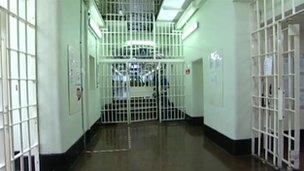Gloucester prison closure: Criminals buried underneath
- Published

The developer of Oxford prison said removing remains was costly
A historian has said there could be up to 122 executed criminals buried in unmarked graves under Gloucester prison.
The jail will close at the end of March and proposals for its future already include a hotel, flats and a museum.
But English Heritage said the site required archaeological investigation before any development takes place.
The Ministry of Justice (MoJ) said it was aware of 17 burials there between 1874 and 1939.
A MoJ spokesman said it was considering the future of these along with the future use of the site.
The prison, a Grade II*-listed building, was built over the levelled remains of Gloucester Castle.
Local historian Phil Moss said public executions took place at the gate lodge up until the middle of the 19th Century.
"Tradition was prisoners were always buried within the prison," he said.
Mr Moss added that there could also be Roman remains beneath the jail.
He said limestone set into the walls of the prison was believed to have come from "a Roman quay or something like that".
But he added not all the bodies will have been buried there.
"According to the records when they were cut down from the gallows sometimes... the body was taken to Gloucester Infirmary and used for anatomical dissection," he added.
'Wealth of material'
Karl Hulker, head of archaeology at the Heritage Collective, said he understood there were remains of the original Roman town beneath the prison.
"There's probably a wealth of material in there charting the entire history of Gloucester, possibly even from prehistoric times," he said.
An English Heritage spokesman said: "Although any archaeology surviving under the prison is not designated, it is of importance to the development of the city of Gloucester.
"As such English Heritage will be closely working with any developer of the site to establish good adaptive reuse of this highly graded listed building.
"We have worked with developers in other areas of the country to achieve this successfully, namely Oxford prison.
"Any redevelopment scheme in Gloucester or any other historic city will have a requirement for archaeological investigation at a level appropriate for the site."
Trevor Osbourne, who developed Oxford prison, said any developer of the Gloucester jail would need to take into account the cost of excavating any remains.
"Clearly there's a great deal of records for Gloucester but you don't always know how complete those records are," he said.
"Therefore it's important you embark on a project like this by doing as much investigation as possible.
"At Oxford we thought it would be about £250,000. It turned out to be more than double that because we kept finding more and more bodies. We found 76 in the end.
"You can't be sure how long it will take or how much it will cost."
- Published15 February 2013
- Published5 February 2013
- Published11 January 2013